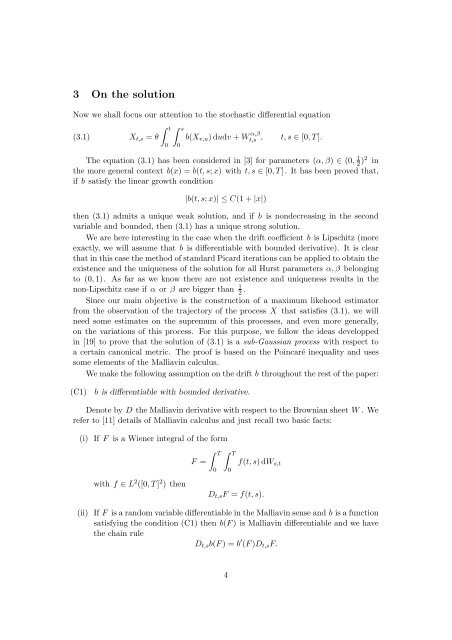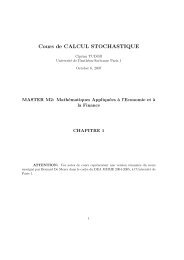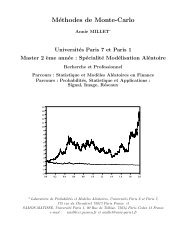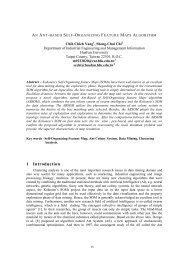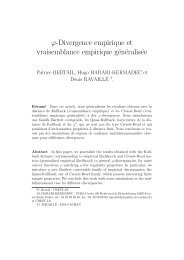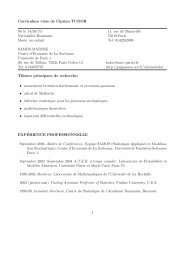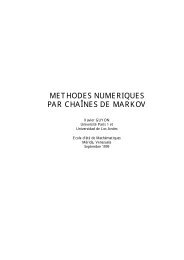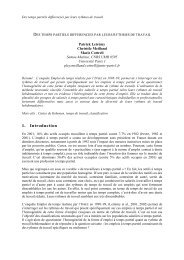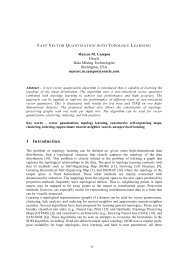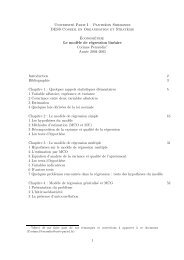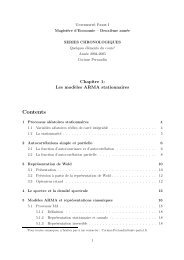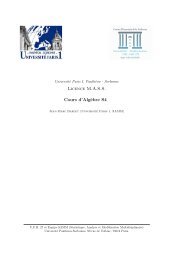Parameter estimation for stochastic equations with ... - samos-matisse
Parameter estimation for stochastic equations with ... - samos-matisse
Parameter estimation for stochastic equations with ... - samos-matisse
Create successful ePaper yourself
Turn your PDF publications into a flip-book with our unique Google optimized e-Paper software.
3 On the solution<br />
Now we shall focus our attention to the <strong>stochastic</strong> differential equation<br />
(3.1) X t,s = θ<br />
∫ t ∫ s<br />
0<br />
0<br />
b(X v,u ) dudv + W α,β<br />
t,s , t, s ∈ [0, T ].<br />
The equation (3.1) has been considered in [3] <strong>for</strong> parameters (α, β) ∈ (0, 1 2 )2 in<br />
the more general context b(x) = b(t, s; x) <strong>with</strong> t, s ∈ [0, T ]. It has been proved that,<br />
if b satisfy the linear growth condition<br />
|b(t, s; x)| ≤ C(1 + |x|)<br />
then (3.1) admits a unique weak solution, and if b is nondecreasing in the second<br />
variable and bounded, then (3.1) has a unique strong solution.<br />
We are here interesting in the case when the drift coefficient b is Lipschitz (more<br />
exactly, we will assume that b is differentiable <strong>with</strong> bounded derivative). It is clear<br />
that in this case the method of standard Picard iterations can be applied to obtain the<br />
existence and the uniqueness of the solution <strong>for</strong> all Hurst parameters α, β belonging<br />
to (0, 1). As far as we know there are not existence and uniqueness results in the<br />
non-Lipschitz case if α or β are bigger than 1 2 .<br />
Since our main objective is the construction of a maximum likehood estimator<br />
from the observation of the trajectory of the process X that satisfies (3.1), we will<br />
need some estimates on the supremum of this processes, and even more generally,<br />
on the variations of this process. For this purpose, we follow the ideas developped<br />
in [19] to prove that the solution of (3.1) is a sub-Gaussian process <strong>with</strong> respect to<br />
a certain canonical metric. The proof is based on the Poincaré inequality and uses<br />
some elements of the Malliavin calculus.<br />
We make the following assumption on the drift b throughout the rest of the paper:<br />
(C1)<br />
b is differentiable <strong>with</strong> bounded derivative.<br />
Denote by D the Malliavin derivative <strong>with</strong> respect to the Brownian sheet W . We<br />
refer to [11] details of Malliavin calculus and just recall two basic facts:<br />
(i) If F is a Wiener integral of the <strong>for</strong>m<br />
<strong>with</strong> f ∈ L 2 ([0, T ] 2 ) then<br />
F =<br />
∫ T ∫ T<br />
0 0<br />
f(t, s) dW s,t<br />
D t,s F = f(t, s).<br />
(ii) If F is a random variable differentiable in the Malliavin sense and b is a function<br />
satisfying the condition (C1) then b(F ) is Malliavin differentiable and we have<br />
the chain rule<br />
D t,s b(F ) = b ′ (F )D t,s F.<br />
4


